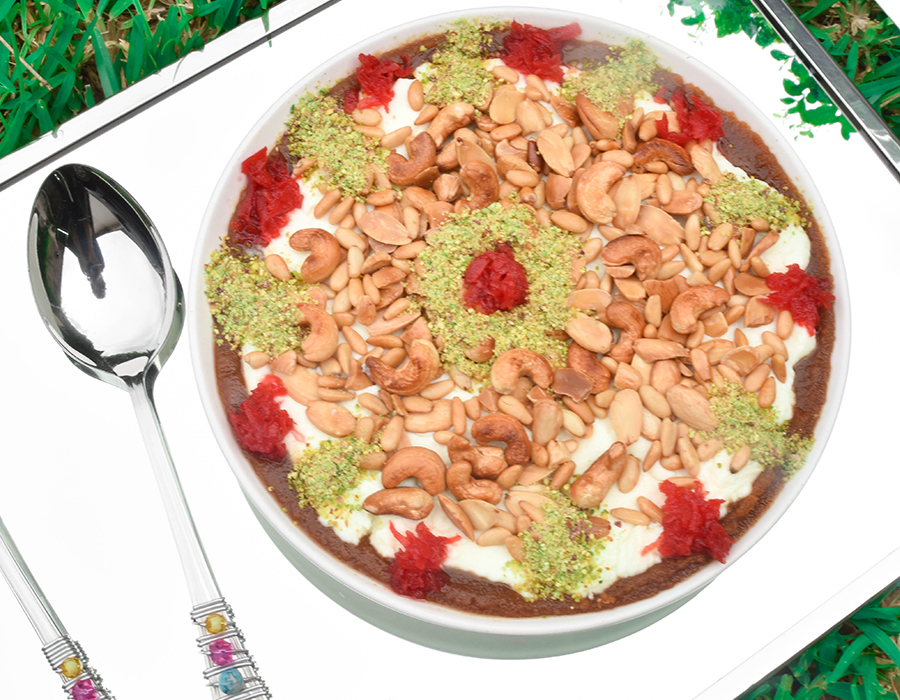
Lebanese Brown Mafroukeh
In Ramadan, I typically find myself immersed in Lebanese sweet production, making multiple batches of znoud el set, maamoul, knafeh, ghraybeh, maamoul mad, halwaet al jibn and mafroukeh to share with family and friends. If you are a regular reader here, you know those delectable sweets, but “Brown Mafroukeh” could be something new to you unless you have been raised in Lebanon or you just have partial Lebanese ancestry! “Brown Mafroukeh” has been a staple dessert in Lebanese cuisine since so long; it has a sweet golden thick brown pudding-like bottom, crowned with a creamy ashta (Lebanese clotted cream) and heavily studded with toasted nuts!
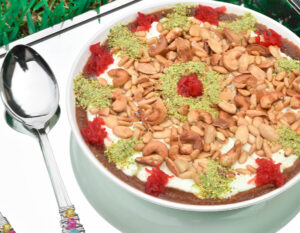
Lebanese Brown Mafroukeh
May we have a show of hands: Who thinks knafeh is the best dessert in Lebanese sweets? Now, who thinks mafroukeh is the best? Not as many hands in the air, but mine is one of them, to me, mafroukeh is a special occasion on its own! You’ll love the crunchy blend of toasted nuts, the irresistible texture of the sweet smack pudding base, and of course, the rich ashta (Lebanese clotted cream) covering it to balance the sweetness. It is This is a make-ahead dessert, which makes it perfect for parties and holidays like Ramadan gatherings and Eid El Fitr, though I make all year long; it looks fancy, but it’s actually quite simple to make, If you’ve never had mafroukeh, you’re in for a treat!

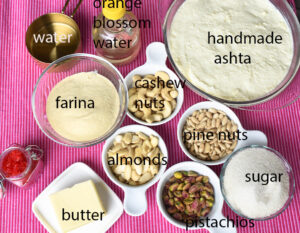
Ingredients needed to make mafroukeh!
- Homemade ashta/ (Lebanese clotted cream), recipe below
- Farek knafeh or farina
- granulated white sugar
- Butter
- A mix of almonds, pine nuts, cashew nuts, you can combine the three or use one type of nuts
- raw shelled pistachios
- Boiled water
- Orange blossom water
- 4 tablespoons sunflower oil, to toast the nuts
- Orange blossom petal jam, optional
Fark Knafeh or Farina?
Traditionally, brown mafroukeh is made with farek knafeh فرك كنافه rather than farina, but finding farek al knafeh could be difficult to purchase in the West. Farek al knafeh is usually bought ready made in Lebanon; after much testing, I found farina to be a good substitute. If you can find farek knafeh, don’t hesitate to use it.
Now let’s get started! Follow the step-by-step instructions and you will be a pro in no time!
To Make the ashta, Lebanese clotted cream
Place the milk, heavy cream, cornstarch and mastic in a saucepan over medium heat, whisking constantly to avoid scorching. Once the liquid comes to a boil, the mixture will begin to work its thickening magic. (It should totally thicken). Set aside, cover with a piece of parchment paper to prevent a skin from forming on top. Leave to cool down completely.

Toast the nuts and grind the pistachios
Heat the oil in a skillet, and stir in the pine nuts, reduce heat to low and cook stirring constantly to a golden color. Remove with a slotted spoon and set aside to cool down. Repeat with the almonds and cashews separately. Drain the nuts on kitchen paper towels.
Transfer the pistchios to a food processor and process until they break down to a smooth powder.
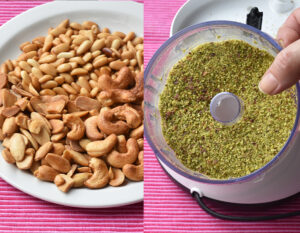
Before diving into making the bottom layer, please read these tips, they could be helpful
- You need to be attentive as you make the caramelized bottom farina layer, a pudding-like that should have that brown color with no hint of a burnt flavor at all. Caramelizing the sugar can go from perfect to burnt in a flash. Be very careful as you heat your caramel —it will cause the caramel to scorch and taste burnt. Once it gets a burnt or bitter flavor, it can’t be saved, follow these two tips for best results!
- Use a heavy bottomed skillet or pan, this will help distribute the heat evenly and ensure the sugar cooks at a steady rate.
- Never melt your caramel on your stove’s highest setting It is important to follow the instructions carefully.
- Choose the right sugar: Granulated white refined sugar is definitely the best as it melts easily and makes the caramel super smooth.
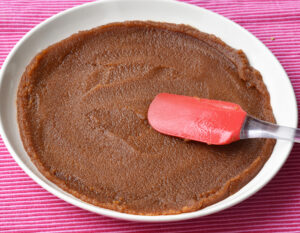
To make the bottom layer, you do have some steps to pace, but for me it’s part of the pleasure of making this dish, it is well worth the time and energy!
Place sugar in a heavy large saucepan and cook over medium to low heat. At the beginning, swirl the saucepan rather than stirring it. When the edges start to put on a golden color, here start stirring until the sugar totally dissolves and turn to a lovely golden color. Note that the sugar may crystallize, that’s o.k, keep on stirring until lumps are no more visible; it takes about 5 minutes. Be careful not to burn it, otherwise it will negatively affect your mafroukeh. 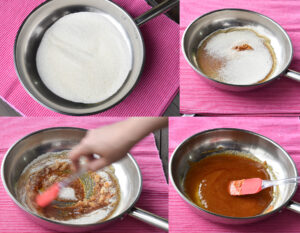
Once sugar is completely melted, immediately stir in the boiling water. Be careful in this step because the caramel will bubble rapidly when the water is added. If you notice the sugar clumps up, keep whisking until it comes back together to a unique caramel liquid, with no visible lumps. Set aside.

Place the farina (dry) in a large wide skillet over medium low heat, stirring constantly until the farina starts to release its earthyscent and until it changes to a dark beige color. It takes about 6 minutes, but please, use your senses rather than exactly abiding by the time mentioned. Add the butter and stir to infuse with farina, the mixture at this stage will resemble breadcrumbs.

Drizzle the caramel you prepared and stir well to homogenize everything together, At this stage the mix looks so runny keep on stirring, note that the heat should be low to avoid burning; add the orange blossom water and keep on stirring. The pudding is ready as soon as all of the syrup is absorbed and the mixture considerably thickens. Note that it will thicken up more after cooling.
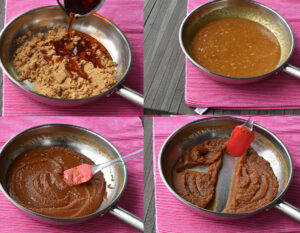
Pile the caramelized farina layer in a wide shallow plate flattening it with the back of the spoon. After the base it is time for a layer of creaminess ashta This layer is key, as it breaks up the heaviness of the bottom layer. Dollop the Lebanese clotted cream(ashta) in the centre of the bowl, then use a spoon or spatula to spread it to the edges. Randomly, spread the toasted nuts over the ashta (the Lebanese clotted cream)and delicately garnish the sides with orange blossom petal jam as the photos show.
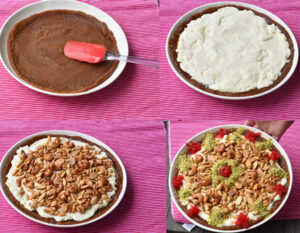
Look how festive and gorgeous this dessert is!
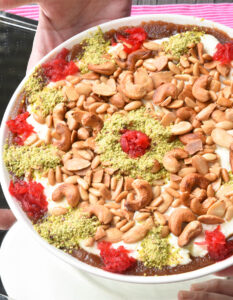
Mafroukeh is a blanket term!
Mafroukeh is a blanket term for two different sweets, just a quick guide explanation can come in handy for anyone traveling to Lebanon. Before ordering this popular sweet you’ll want to identify the interchangeable name when the word mafoukeh occurs, simply because there are two different mafroukeh sweets, one made with farek knafeh and caramelized sugar, which I am happily to share with you, and another great pistachio mafroukeh, obviously as the name refers, made of pistachios and farek kunafah (grind kataifi dough). Both are amazing, you will find the recipe of pistachio mafroukeh in my book!

We love this dessert. If you are a fan of Lebanese desserts, this mafroukeh recipe doesn’t disappoint.
Brown mafroukeh has a sweet dense pudding- like bottom covered with a creamy ashta(Lebanese clotted cream) and packed with toasted nuts. It is unique and special in flavor and texture, plus it’s fairly easy to make. For some of you making mafroukeh can seem a little intimidating. With a few tips and a tried-and-true recipe, which I’m happy to share with you, even novice bakers can whip up a decent mafroukeh. This is a worthy dessert.
- Author: Hadia Zebib Khanafer
- Serving: 3 to 4 persons
- Cuisine: Lebanese
Ingredients:
To make the Lebanese clotted Cream (Ashta):
- 1 1/2 cups milk
- 1/2 cup heavy cream
- 2 heaped tablespoons cornstarch
- 1/4 teaspoon mastic gum crushed with a pinch of sugar
To make the semolina bottom layer:
- 1 cup sugar
- 1 cup boiling water
- 1 cup farek knafeh or farina, traditinally mafroukeh is made of farek knafeh, but I used farina as a substitute
- 100 grams/ 3.5 oz, butter, room temperature
- 2 tablespoons orange blossom water
For the upper layer:
- 1/4 cup of pine nuts
- 1/4 cup sliced almonds
- 1/4 cup cashew nutsix of nuts
- Orange blossom jam (mraba zahr allaymoun), optional
4 tablespoons sunflower oil, to toast the nuts
Directions:
To toast the nuts:
Place the sunflower oil in a large skillet over medium heat and toast the pine nuts, stirring regularly to a golden color. Remove with a slotted spoon and toast separately , the cashews and almonds to a lovely golden color, make sure to keep the heat low to avoid burning the nuts.
To make the ashta (Middle Eastern clotted cream):
- Place the milk, heavy cream, cornstarch and mastic in a saucepan over medium heat, whisking constantly to avoid scorching. Once the liquid comes to a boil, the mixture will begin to work its thickening magic. (It should totally thicken). Set aside, cover with a piece of parchment paper to prevent a skin from forming on top. Leave to cool down completely.
To make the caramelized farina bottom layer:
- Place sugar in a heavy large saucepan and cook over medium to low heat. At the beginning, swirl the saucepan rather than stirring it. When the edges start to put on a golden color, here start stirring until the sugar totally dissolves and turn to a lovely golden color. this takes about 5 minutes. Be careful not to burn it, otherwise it will negatively affect your mafroukeh
- Once sugar is completely melted, immediately stir in the boiling water. Be careful in this step because the caramel will bubble rapidly when the water is added. If you notice the sugar clumps up, keep whisking until it comes back together to a unique caramel liquid, with no visible lumps. Set aside.
- Place the farina in a large wide skillet (dry) over medium low heat, stirring constantly until the farina starts to change to a dark beige color. Add the butter and stir to infuse the butter and farina together, the mixture at this satge will resemble breadcrumbs. Drizzle the caramel you prepared and stir well to homogenize everything together, at this stage the mix looks so liquidy, keep on stirring, note that the heat should be low to avoid burning, add the orange blossom water and keep on stirring. The pudding is ready as soon as all of the syrup is absorbed and the mixture considerably thickens. Note that it will thicken up more after cooling.
To assemble:
- Pile the caramelized farina layer in a wide shallow plate flattening it with the back of the spoon.
- After the base it is time for a layer of creaminess ashta This layer is key, as it breaks up the heaviness of the bottom layer. Dollop the Lebanese clotted cream (ashta) in the center of the bowl, then use a spoon or spatula to spread it to the edges.
- Randomly, spread the toasted nuts over the ashta (the Lebanese clotted cream) and delicately garnish the sides with orange blossom petal jam as the photos show.
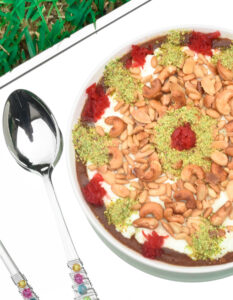
Note: Traditionally, brown mafroukeh is made with farek knafeh rather than farina, but finding farek al knafeh could be difficult to purchase in the West, after much testing, I found farina to be a good substitute. If you can find farek knafeh, don’t hesitate to use it.
If you make the ” Lebanese Brown Mafroukeh“, leave a comment below, or share your pictures on Facebook! I would love to see your creations!! Hashtag, #Hadia’s lebanese Cuisine
Subscribe to Our Newsletter
Instructions
No Steps Found !
- Course : DESSERTS
- Recipe Type : DESSERTS, DESSERTS, LEBANESE RECIPES, RECIPES FROM AROUND THE WORD
About Chef
Hadia Zebib
I am Hadia, the face behind Hadia’s Lebanese Cuisine. I grew up in Beirut Lebanon and I currently reside in Kinshasa, Congo with my husband and my three adorable sons, ...
Read more about this chef..

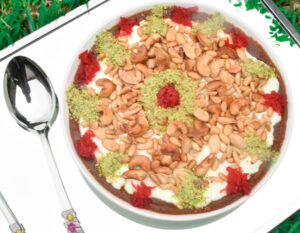
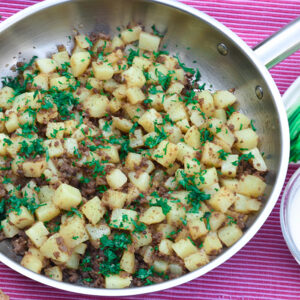
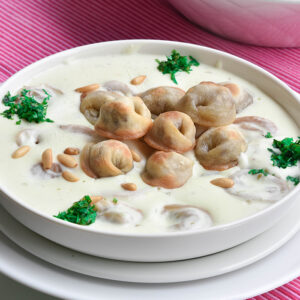


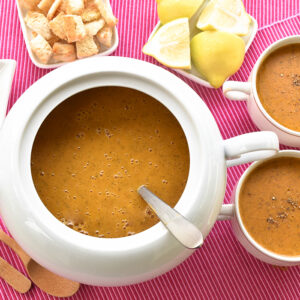
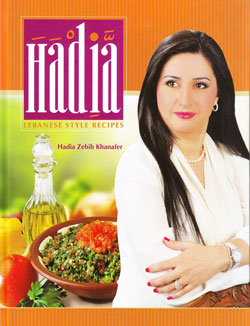
No comments yet.